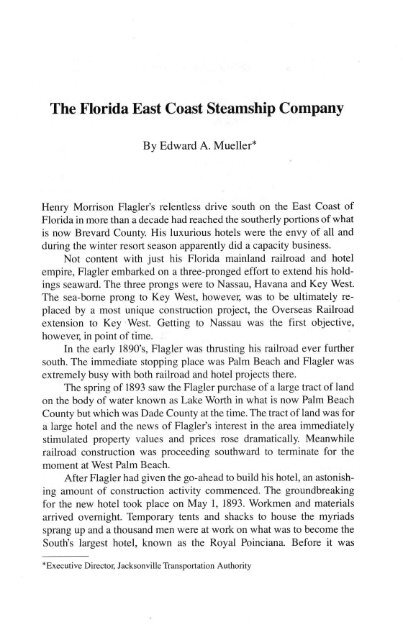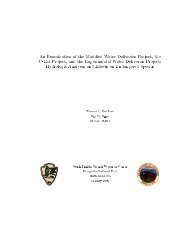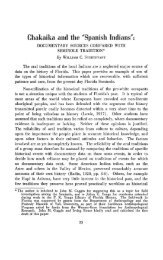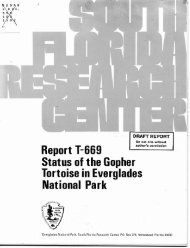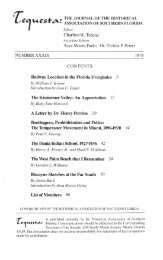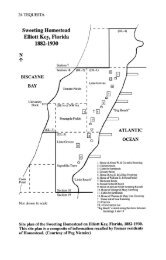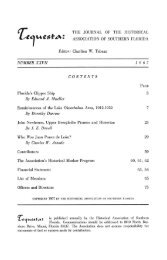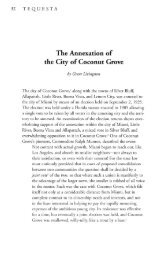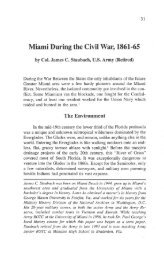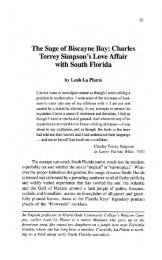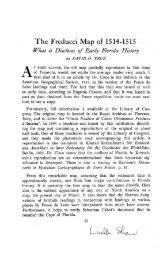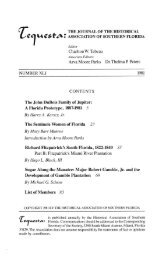The Florida East Coast Steamship Company - FIU Digital Collections
The Florida East Coast Steamship Company - FIU Digital Collections
The Florida East Coast Steamship Company - FIU Digital Collections
Create successful ePaper yourself
Turn your PDF publications into a flip-book with our unique Google optimized e-Paper software.
<strong>The</strong> <strong>Florida</strong> <strong>East</strong> <strong>Coast</strong> <strong>Steamship</strong> <strong>Company</strong><br />
By Edward A. Mueller*<br />
Henry Morrison Flagler's relentless drive south on the <strong>East</strong> <strong>Coast</strong> of<br />
<strong>Florida</strong> in more than a decade had reached the southerly portions of what<br />
is now Brevard County. His luxurious hotels were the envy of all and<br />
during the winter resort season apparently did a capacity business.<br />
Not content with just his <strong>Florida</strong> mainland railroad and hotel<br />
empire, Flagler embarked on a three-pronged effort to extend his holdings<br />
seaward. <strong>The</strong> three prongs were to Nassau, Havana and Key West.<br />
<strong>The</strong> sea-borne prong to Key West, however, was to be ultimately replaced<br />
by a most unique construction project, the Overseas Railroad<br />
extension to Key West. Getting to Nassau was the first objective,<br />
however, in point of time.<br />
In the early 1890's, Flagler was thrusting his railroad ever further<br />
south. <strong>The</strong> immediate stopping place was Palm Beach and Flagler was<br />
extremely busy with both railroad and hotel projects there.<br />
<strong>The</strong> spring of 1893 saw the Flagler purchase of a large tract of land<br />
on the body of water known as Lake Worth in what is now Palm Beach<br />
County but which was Dade County at the time. <strong>The</strong> tract of land was for<br />
a large hotel and the news of Flagler's interest in the area immediately<br />
stimulated property values and prices rose dramatically. Meanwhile<br />
railroad construction was proceeding southward to terminate for the<br />
moment at West Palm Beach.<br />
After Flagler had given the go-ahead to build his hotel, an astonishing<br />
amount of construction activity commenced. <strong>The</strong> groundbreaking<br />
for the new hotel took place on May 1, 1893. Workmen and materials<br />
arrived overnight. Temporary tents and shacks to house the myriads<br />
sprang up and a thousand men were at work on what was to become the<br />
South's largest hotel, known as the Royal Poinciana. Before it was<br />
*Executive Director, Jacksonville Transportation Authority
44 TEQUESTA<br />
completed and opened on February 15, 1894, it had consumed five<br />
million feet of timber, 360 thousand shingles, half a million bricks, four<br />
thousand barrels of lime and 2,400 gallons of paint. Also 1,200 windows<br />
and 1,800 doors were installed in the Poinciana. Some 20 acres of walls<br />
were plastered. <strong>The</strong>se figures would be formidable for almost any area<br />
today, one can imagine what the impact was on a sleepy pioneer settlement<br />
that was to be known as "<strong>The</strong> Queen of Winter Resorts."<br />
A year later in the summer of 1895, construction was commenced<br />
on another large hotel in the area, this time one that faced the ocean. It<br />
was the Palm Beach Inn, later to be world renowned as "<strong>The</strong> Breakers."<br />
<strong>The</strong> key to Flagler's plans was the linking of transportation and<br />
accommodations. He believed in close proximity and a relationship<br />
between them in terms of convenience to guests. Because his railroad<br />
was on the mainland at West Palm Beach, several miles away from the<br />
Royal Poinciana and Palm Beach Inn, a spur had to be built over to the<br />
ocean front from the mainland, across Lake Worth. This spur, built before<br />
the Inn opened, helped in the transfer of building supplies for the<br />
construction of the Inn. <strong>The</strong> spur was extended for over 1,000 feet into<br />
the ocean adjacent to the Inn, by construction of a pier capable of<br />
carrying trains. This would enable passengers to step from their train<br />
directly to the boat. Hotel guests needed only a short walk from their<br />
room to reach their vessel. Of course the pier had to be placed out a<br />
considerable distance to enable even the shallow draft vessels used at<br />
that time enough depth of water so as not to run aground.<br />
<strong>The</strong> "immense pier" as it was described in promotional travel<br />
literature was built under contract by Captain J.D. Ross, a prominent<br />
marine contractor from Jacksonville. Captain Ross had constructed<br />
some of the St. John's River jetty work which was placed to make that<br />
river capable of carrying deeper draft vessels. Plans called for a timber<br />
trestle type pier, probably supported by piling (wooden) and a heavy<br />
bulkhead filled with rock at the far end of the pier, undoubtedly to hold<br />
against the expected hurricane-sized weather that occasionally developed.<br />
<strong>The</strong> pier had to be heavy enough also to carry the locomotives<br />
of the day and lighter coaches. Cost was put at $100,000 in 1897. <strong>The</strong>n the<br />
pier was used for fishing and boating activities.<br />
Flagler's dreams (dreams at the time, realities as events were to<br />
prove) included participation in the winter tourist trade with the<br />
Bahamas and to that purpose he acquired a brace of hotels in Nassau, the<br />
Royal Victoria and Colonial. And, of course, the next step would be to
<strong>The</strong> <strong>Florida</strong> <strong>East</strong> <strong>Coast</strong> <strong>Steamship</strong> <strong>Company</strong> 45<br />
provide the connecting link between Palm Beach and Nassau, an oceangoing<br />
vessel.<br />
So, in mid-October, 1895, announcement was made of a steamship<br />
service to Nassau, such service to start in mid-January, 1896. <strong>The</strong><br />
Northumberland was the initial vessel chosen for this purpose. This<br />
vessel was chartered and was about three years old at the time. She was a<br />
steel vessel, had twin screws, was of 1,300 tons and was 220 feet long<br />
and 33 feet wide. She had a single stack and two masts.<br />
Flagler's steamship operations were organized under a general<br />
corporate entry known as the <strong>Florida</strong> <strong>East</strong> <strong>Coast</strong> <strong>Steamship</strong> <strong>Company</strong>.<br />
Two services were operated after the first year, the <strong>Florida</strong>-Bahamas<br />
<strong>Steamship</strong> Line and the Key West and Miami <strong>Steamship</strong> Line. Thus<br />
Northumberland was operated by the <strong>Florida</strong>-Bahamas <strong>Steamship</strong> Line.<br />
<strong>The</strong> President of the <strong>Florida</strong> <strong>East</strong> <strong>Coast</strong> <strong>Steamship</strong> <strong>Company</strong> was<br />
Mr. Flagler and Vice-President was Joseph R. Parrott. <strong>The</strong>se two principals<br />
were also the top officers in the parent <strong>Florida</strong> <strong>East</strong> <strong>Coast</strong> Railroad.<br />
<strong>The</strong> Northumberland inaugurated service either on January 15<br />
(Wednesday) or on the next day, January 16. One published schedule<br />
says the 16th and a later one indicates the 15th. It was just an overnight<br />
jaunt to Nassau on New Providence Island, the city of Nassau being<br />
reached just in time for breakfast. On Monday, January 20, Northumberland<br />
left Nassau for the first time and by February 11 had settled down to<br />
a tri-weekly Tuesday, Thursday, Saturday departure from Palm Beach and<br />
a Monday, Wednesday, Friday departure from Nassau. Service was<br />
discontinued by the first of April as the winter visitor season was over by<br />
then.<br />
<strong>The</strong> Palm Beach Inn was open from December to April and the<br />
Royal Poinciana from January to April. <strong>The</strong> Royal Poinciana was six<br />
stories high, had 575 sleeping rooms, a ballroom, dining room, and<br />
sitting and parlor rooms. Two swimming pools were provided, one with<br />
sulphur water and one with salt water from the ocean. During the<br />
1894-95 season, visitors were turned away for lack of space. <strong>The</strong> Palm<br />
Beach Inn By <strong>The</strong> Sea as it was termed, was of about five stories and had<br />
some 400 guest rooms. Later on it would gain fame when it became<br />
known as "<strong>The</strong> Breakers"<br />
As Nassau was only 150 miles from the United States, the journey<br />
was a convenient half day trip from the mainland. Its climate was more<br />
tropical than any found in the U.S. at that time and winter sunshine<br />
seemed its chief selling point. Cycling was avidly resorted to, and the
46 TEQUESTA<br />
beautifully-colored shallow coral-strewn waters around the area were<br />
also an attraction. <strong>The</strong> Royal Victoria Hotel had been built by the British<br />
Colonial government at a cost of $125,000 and was four stories high, 200<br />
feet long with wide verandahs around its lower three floors. <strong>The</strong> <strong>Florida</strong><br />
<strong>East</strong> <strong>Coast</strong> publicity noted that the hotel manager was an American, no<br />
less.<br />
<strong>The</strong> Key West operations also commenced in 1896. <strong>The</strong> Shelter<br />
Island, a sidewheeler was to start this service in mid-February from<br />
Miami. <strong>The</strong> schedule called for tri-weekly trips on Tuesday, Thursday,<br />
and Saturday, leaving Miami at 8 A.M., Coral Gables at 9 A.M. with<br />
arrival at Key West at 6 P.M. <strong>The</strong> return trips were scheduled to have<br />
Shelter Island leave Key West on Monday, Wednesday and Friday at 8<br />
A.M., arriving at Coral Gables at 5 PM. and Miami at 6 PM. <strong>The</strong> total trip<br />
distance was about 165 miles.<br />
Shelter Island was an iron paddlewheeled vessel built in 1886 at<br />
Harlan and Hollingsworth's Delaware River shipyard. She was 176 feet<br />
long, 31 feet wide and of 10 foot draft. She had a vertical beam engine, 38<br />
inches in diameter with an 108 inch stroke. She was of 648 gross tons,<br />
484 net.<br />
Shelter Island had the briefest career imaginable with the FEC. On<br />
February 20, 1896 she left Miami for Key West on her very first trip.<br />
Over 200 citizens of Key West came aboard her to have the honor of the<br />
first passage and many from Jacksonville were also among her passengers.<br />
Only two hours out of Miami she struck a rocky shoal or perhaps a<br />
coral-like protrusion between Grecian and Mosquito Shoals in six feet of<br />
water. She got free of the obstruction, turned on her pumps and started<br />
for Key West. Initially the pumping kept the water down but the leak<br />
became greater, the pumps became clogged and were thus unable to keep<br />
the water level from rising. Finally, the furnace fires went out due to the<br />
advancing water, steam pressure and motive power ceased, and Shelter<br />
Island settled to the bottom some 19 miles out of Key West. She had lost<br />
the 90 mile run to the supposed help at Key West in the form of a marine<br />
railway on which she had hoped to have her repairs effected.<br />
No casualties resulted but Shelter Island, valued at $80,000, was a<br />
total loss. She was insured for some $60,000, however. Two Key West<br />
tugs, the Clyde and Childs came out to help and took off some of the<br />
passengers and cargo. Two wrecking schooners also arrived on the scene<br />
and "helped" with the cargo. Surprisingly enough the Shelter Island was<br />
in charge of a veteran pilot, Captain Cannte and the holing of the hull was<br />
a surprise to all.
<strong>The</strong> <strong>Florida</strong> <strong>East</strong> <strong>Coast</strong> <strong>Steamship</strong> <strong>Company</strong> 47<br />
Shelter Island had been chartered from the Montauk Steamboat<br />
<strong>Company</strong> for the winter run to Key West. In the summer she was on a run<br />
from New York city to the outer extremities of Long Island and had at<br />
least 50 staterooms as she was a night boat. She had cleared from New<br />
York only a week before on the 13th and had stopped off at Jacksonville<br />
on the 16th. <strong>The</strong> Miami-Key West Line immediately set out to find a<br />
suitable replacement (of which more later).<br />
An intermediate service was also run at this time from Fort Lauderdale<br />
to Miami using Biscayne, a western-rivers type sternwheeler previously<br />
used by the Indian River Steamboat Line. Flagler's railroad had<br />
caused steamboat operations on the Indian River to dwindle away and<br />
surplus boats were accordingly available. Biscayne had previously been<br />
named (a) J.W. Sweeney. Biscayne scheduled a tri-weekly service leaving<br />
Fort Lauderdale at 9 A.M., arriving at Miami at 3 P.M., and went on to<br />
Coconut Grove, getting there at 4 P.M. <strong>The</strong> return trip left Coconut Grove<br />
at 9 A.M., Miami at 10 A.M. and reached Fort Lauderdale at 4 P.M. <strong>The</strong><br />
southbound trip was made on Monday, Wednesday and Friday and the<br />
northbound one on Tuesday, Thursday and Saturday.<br />
Della alternated with Biscayne going southward on Tuesday,<br />
Thursday and Saturday and returned on Monday, Wednesday and Friday.<br />
Della, #157384, was a small steel propeller vessel of 38 gross tons, 22<br />
net. She was only 67.5 feet long and 18.1 feet wide but was a good<br />
shallow water vessel as her depth of hold was three feet. Her engine was<br />
of 30 indicated horsepower and she was built in Jacksonville in 1893.<br />
Biscayne, #76769, was a wooden sterwheel vessel having been<br />
Courtesy of the Mariners Museum<br />
<strong>The</strong> ill-fated Shelter Island
48 TEQUESTA<br />
built at Abbeville, Georgia in 1888. She was a comfortable 414 gross<br />
tons, 229 net, had an 80 (nominal) horsepower engine (120 indicated)<br />
and was 118.9 feet long, 34.4 feet wide and of 4.4 feet in depth.<br />
Of course, Flagler was busily engaged in extending his railroad line<br />
to Miami but it was not until mid-April, 1896 that the railroad was<br />
completed, the first train bearing passengers arriving around April 22.<br />
Flagler had had severe doubts about going further south than the<br />
Palm Beaches at this time but a severe freeze over the winter of 1894-95<br />
in the Palm Beach area and the absence of such a condition in the Miami<br />
area convinced him to look southward, somewhat before he ordinarily<br />
would have done so. <strong>The</strong> Tuttles and Brickells, pioneer land holders in<br />
the Miami area, offered alternate lots from their holdings and Mrs. Julia<br />
Tuttle also gave 100 acres of land along Biscayne Bay and the Miami<br />
River for a hotel site. Flagler on his part was to extend his railroad,<br />
construct a large hotel and clear streets, finance waterworks and an<br />
electric light plant.<br />
Surveys for the railroad started in June, 1895 track laying began by<br />
September. <strong>The</strong> usual bands of newcomers, settlers and workers made<br />
their way to Miami. In March, 1896, within two days, two steamboats<br />
(one of them the St. Lucie) arrived with building materials and some of<br />
Flagler's underlings. <strong>The</strong>y started work on the hotel and announced that<br />
the railroad would be in Miami in about 30 days.<br />
<strong>The</strong> Flagler hotel completed in time for the 1897 tourist season was<br />
the Royal Palm. This large hotel could accommodate 600 guests and<br />
stayed open from January to April. A smaller hotel, the Biscayne with<br />
quarters for 150 guests was also available.<br />
Now that Miami was the obvious terminal, Palm Beach was abandoned<br />
as the departure point for Nassau and Miami took over. <strong>The</strong><br />
Northumberland was not chartered for the 1897 season, the Monticello<br />
being instead obtained. This vessel was the old City of Monticello,<br />
#5339, a durable iron sidewheeler which had formerly plied from<br />
Charleston to Jacksonville in the mid-1880's after a respectable career<br />
with the Morgan Line.<br />
Monticello or City of Monticello (her full name) was over 30 years<br />
old at the time of her service with Flagler. An iron hulled vessel she was a<br />
Harlan and Hollingsworth product (their hull #101) being built in 1866.<br />
She was a beam-engined craft with a 32 inch cylinder and a nine foot<br />
stroke for her piston. She was 892 tons, gross and 478, net. Her length<br />
was 224 feet and she was 32 feet wide with a nine foot hold depth. <strong>The</strong>
<strong>The</strong> <strong>Florida</strong> <strong>East</strong> <strong>Coast</strong> <strong>Steamship</strong> <strong>Company</strong> 49<br />
<strong>Florida</strong> <strong>East</strong> <strong>Coast</strong> <strong>Steamship</strong> Line chartered her from the Bay of Fundy<br />
<strong>Steamship</strong> <strong>Company</strong>.<br />
Monticello was originally named (a) City of Norfolk and she had<br />
been sold to British interests in 1889 after her St. Johns service in the<br />
mid-1880's. Before that she had a long stint with the Morgan <strong>Steamship</strong><br />
Line.<br />
Miami was somewhat closer to Nassau than Key West and Monticello<br />
was placed on a Wednesday and Saturday departure schedule,<br />
leaving Miami from mid-January to mid-February and a Tuesday and<br />
Friday return schedule from the Bahamas. From February 15 to March<br />
27 she sailed tri-weekly from Miami on Tuesday, Thursday and Saturday<br />
and returned from Nassau on Monday, Wednesday and Friday. All<br />
sailings were at 2 P.M. with early morning arrivals at their destinations.<br />
Sailings went back to a twice-a-week basis in late March until the end of<br />
the season in mid-April. Nassau was some 155 miles from Miami.<br />
For the Key West route, to replace the short-lived Shelter Island, the<br />
venerable City of Richmond was purachased and renamed (b) City of Key<br />
West in honor of her new home. This ancient wooden sidewheeler would<br />
give good service during the next several years as she threaded the<br />
"Inside" and "Outside" passages among the <strong>Florida</strong> Keys to and from<br />
Key West. She ran on a tri-weekly basis the entire season, leaving Miami<br />
on Tuesday, Thursday and Saturday and Key West on Sunday, Wednesday<br />
and Friday. Departures from both ends were at 7 A.M. so the maximum<br />
amount of daylight could be employed in the navigational hazards of the<br />
shoals enroute.<br />
City of Key West, #5020, first saw the light of day in 1865 at her<br />
building in Athens, New York, Nathan and Edmonds being the constructor.<br />
Her durability was attested to by the fact that she was to have over<br />
forty years of active life and perhaps several less active years afterwards.<br />
She was distinguished by a sort of sway-backed appearance, tending to<br />
indicate that her powerful vertical beam engine located amidships was<br />
just too heavy for her. After an initial few months on the James River<br />
between Richmond and Norfolk just after the Civil War she went north to<br />
Maine waters. From 1866 to 1893 she was a "down-easter" being<br />
operated by the Portland, Bangor, Mt. Desert and Machias Steamboat<br />
<strong>Company</strong> (or one of its earlier predecessors under a similar nomenclature.)<br />
In 1893, still going by her original name of City of Richmond, she<br />
was sold to New London, Connecticut interests who had her for three
50 TEQUESTA<br />
years until her purchase by a St. Augustine, <strong>Florida</strong> resident. She spent a<br />
few months in <strong>Florida</strong> as City of Richmond and was in some way<br />
involved in helping to land munitions and men in Cuba during the<br />
filibustering days that preceded the Spanish American War. She rendezvoused<br />
with many filibustering vessels such as the famed Three<br />
Friends. However, in 1896 the <strong>Florida</strong> <strong>East</strong> <strong>Coast</strong> purchased her as a<br />
replacement for the ill-fated Shelter Island.<br />
City of Richmond's chief Maine route was from Portland to Bangor<br />
using the so-called inside sheltered passage. She was of 939 gross tons,<br />
600 net and her dimensions were 227.5 x 30.6 x 10 feet. A beam-engined<br />
vessel, her cylinder was 36 inches in diameter and her stroke was 12 feet.<br />
Her paddle wheels were 36 feet in diameter.<br />
City of Richmond while in Maine service had one very serious<br />
accident. She was a very fast boat, the fastest on her route in fact and on a<br />
foggy morning in August, 1881 she ran aground on a ledge off Mark<br />
Island on the Maine coast. No lives were lost and the passengers were all<br />
safely landed. Her hull was severely damaged and in the repair her<br />
walking beam engine, stack and boilers were removed. Some ten years<br />
later when laid up for the winter at Pier 24, <strong>East</strong> River, New York City, she<br />
burned early in 1891. When raised in mid-March, 1891 two bodies<br />
(probably hoboes caught in the fire) were found in the wreckage.<br />
After two seasons of running chartered vessels to Nassau, the<br />
ordering of a specialized new vessel for that service took place. William<br />
Cramp and Sons of Philadelphia were commissioned to build the suitable<br />
vessel and the result was Miami, #92830, a steel twin screw vessel.<br />
She bore Cramp's hull number 292 and was launched on October 23,<br />
1897.<br />
Miami was 239.2 feet by 40.1 feet and was 21.8 feet in depth. She<br />
was of 1,741 gross and 1,311 net tons. She was powered by two engines,<br />
triple expansion ones with cylinders of 18" 27" and 42" diameter with 25<br />
inch stroke. She had a usual speed of 131/2 knots and had a reputed top<br />
speed of 16 knots. Features were electric lights and fans in every room.<br />
She could accommodate 125 passengers and was rated at 2,000 horsepower.<br />
<strong>The</strong> FEC had signed the contract with Cramps on June 28, 1897, the<br />
keel was laid on July 3, the first frames were erected on July 31 and she<br />
was ready for sailing in December. At her October launching she was<br />
christened with a bottle of wine by Miss Julie Russell Parsons, daughter<br />
of R.M. Parsons, a Flagler vice-president. <strong>The</strong> guest list of those attend-
<strong>The</strong> <strong>Florida</strong> <strong>East</strong> <strong>Coast</strong> <strong>Steamship</strong> <strong>Company</strong> 51<br />
ing read like a who's who of Flagler's friends. Richard Harding Davis, the<br />
soon-to-be-famous Spanish American war correspondent was also<br />
among the gathering.<br />
Construction of Miami took place between a new steamer yacht,<br />
Dorothea, and a Japanese cruiser, Kasagi. Also underway in the same<br />
yard was the new U.S. battleship Alabama. Three Japanese naval commanders,<br />
Narita, Aoki and Takakura, were on hand to supervise the<br />
building of their Kasagi and also as guests partook in the launching<br />
ceremonies.<br />
<strong>The</strong> Miami started her Nassau run in early 1898, the first run being<br />
on the 17th of January. As was the prior pattern she ran semi-weekly from<br />
March 29 to April 12. She departed Miami at 4 P.M. and arrived at Nassau<br />
early the next morning. Undoubtedly the approximate time schedule was<br />
followed in reverse on the return from Nassau.<br />
<strong>The</strong> interior decorations and furnishings of the three-decked, twotiered<br />
stateroom vessel were most elaborate. Cabins and staterooms<br />
were to be finished in white mahogany and gold. <strong>The</strong> midships dining<br />
room was tiled with rubber interlocking tiling in three colors to go along<br />
with the white and gold trim. A vaulted dome over the center "diffuses<br />
the room with truly artistic effect."<br />
<strong>The</strong> 1898 season for the <strong>Florida</strong> <strong>East</strong> <strong>Coast</strong> in addition to the new<br />
Miami going to Nassau from Miami saw the City of Key West still on her<br />
routing to Key West. <strong>The</strong> Flagler interests had seen to it that a suitable<br />
hotel for visitors was available there, the Hotel Key West being first<br />
opened on February 15, 1897. However it remained open all year round<br />
contrasted to the winter operations of the other Flagler hotels. Most<br />
conveniently, the Hotel Key West was about three minutes walk from the<br />
steamship piers. Key West in those days was a port of some consequence<br />
as steamers from the Plant Line, Morgan <strong>Steamship</strong> <strong>Company</strong> and<br />
Mallory Line touched there.<br />
For the 1898 season City of Key West was apparently captained by<br />
Stephen Bravo, one of the famous captains of <strong>Florida</strong>'s steamboat days.<br />
He had served on the DeBary Line on the St. Johns, as well as the Indian<br />
River Steamboat <strong>Company</strong>'s craft and was to work further with Flagler<br />
on the Overseas Railroad extension to Key West after the turn of the<br />
century. He is usually associated with the St. Lucie being her captain<br />
most of the time. Bravo was well-regarded by Flagler, such as the<br />
available records indicate.<br />
City of Key West usually operated year round except for overhauls
52 TEQUESTA<br />
in the city she was named for. On one such occasion in November, 1898,<br />
Miami replaced City of Key West briefly on the Miami-Key West route<br />
when the latter had to be overhauled at Wilmington, Delaware.<br />
<strong>The</strong> destruction of the U.S.S. Maine in Havana harbor in mid-<br />
February, 1898 and the resulting Spanish American War focused increased<br />
interest on Cuba. <strong>The</strong> tourist business could only increase after<br />
the short war was over and the Flagler interest resulted in the establishment<br />
of the third of the three prongs, the Miami to Havana route.<br />
To establish this service another vessel, of course, was needed. So<br />
the third vessel in the <strong>Florida</strong> <strong>East</strong> <strong>Coast</strong> system became (c) Cocoa,<br />
#127271, an 1879 Neafie and Levy of Philadelphia product. She had<br />
been built originally for Spain as (a) Cuba and during the war she was<br />
captured as a prize of war by the USS Nashville off Cienfuegos, Cuba on<br />
April 29, 1898. She was named (b) Argonauta at the time and by fall had<br />
accrued to the <strong>Florida</strong> <strong>East</strong> <strong>Coast</strong>. Renamed by the FEC as Cocoa, she<br />
was of 1,214 gross tons, 941, net. She was 205.4 feet long, 36 feet wide<br />
and was an iron propeller vessel of 700 horsepower.<br />
Cocoa was not enough for the demands of the three individual<br />
routes so another vessel was acquired for the 1899 season, this time by<br />
charter. She was the Lincoln and the Kennebec Steamboat <strong>Company</strong> was<br />
her owner. Her charter was from October 27, 1898 to May, 1899.<br />
Evidently she suited the FEC for they acquired her by purchase in<br />
November, 1899.<br />
<strong>The</strong> Kennebec Steamboat <strong>Company</strong> had her built in 1897 as Lincoln,<br />
#141499, by the New England Shipbuilding <strong>Company</strong> of Bath,<br />
Maine. Kennebec offered Lincoln on their Boston to Maine route apparently<br />
not too successfully, however. She was 203.4 feet long, 37.9 feet<br />
wide and 12.6 feet in depth. Her tonnage was 996 gross and 532 net and<br />
she had 1,600 indicated horsepower. She was a wooden twin-screw<br />
vessel, her two engines were of the triple expansion type, 15" 26" and<br />
39" diameter cylinders with 28 inch stroke.<br />
Accordingly for 1899 the three runs were in effect. City of Key West<br />
still was on the route from Miami to Key West. Since trains now came to<br />
Miami the vessel left on a schedule of Monday, Wednesday and Friday<br />
departures at 11 P.M. after arrival of the trains from the north. Key West<br />
was reached at noon the following day. After a three hour layover, the<br />
City left at 3 P.M. for the return trip to Miami.<br />
On the Miami-Havana routing, Lincoln originally ran a Sunday and<br />
Wednesday departure schedule, leaving at 11 P.M. from Miami after trains
<strong>The</strong> <strong>Florida</strong> <strong>East</strong> <strong>Coast</strong> <strong>Steamship</strong> <strong>Company</strong> 53<br />
arrived and got to Havana at 3 P.M. the next day. Lincoln left Havana at<br />
noon on Tuesday and Friday and arrived in Miami the next day at 5 A.M.<br />
(Wednesday and Saturday).<br />
<strong>The</strong> Miami-Nassau Line still ran semi-weekly the first part of the<br />
season, tri-weekly February 6 to April 4 and back to semi-weekly from<br />
April 4 to closing on the 20th. In 1899 the "season" actually started on<br />
December 1, 1898 and the Lincoln took the run until Miami came on on<br />
January 10. Cocoa also ran between Miami and Nassau according to the<br />
Nautical Gazette.<br />
<strong>The</strong> FEC bought Lincoln in 1899 and renamed her (b) Martinque<br />
after doing so.<br />
<strong>The</strong> 1900 season saw the three separate lines being run much as in<br />
the preceding year. However, the <strong>Florida</strong> <strong>East</strong> <strong>Coast</strong> <strong>Steamship</strong> <strong>Company</strong><br />
had run its last winter season after the April visitors had ceased. In<br />
July, 1900 the Flagler interests and the Plant <strong>Steamship</strong> service consolidated<br />
their positions by merging their Miami and Tampa-based services.<br />
On July 24, 1900 the FEC vessels were officially transferred to the new<br />
line, the Peninsular and Occidental <strong>Steamship</strong> <strong>Company</strong>, a service that<br />
was to last for six and a half decades.<br />
(Note: Basic sources for this article consist of U.S. vessel records, information from<br />
informal records of the Mariners Museum, newspaper sources and schedules and<br />
timetables of the period. <strong>The</strong> Flagler Museum was especially helpful.)


